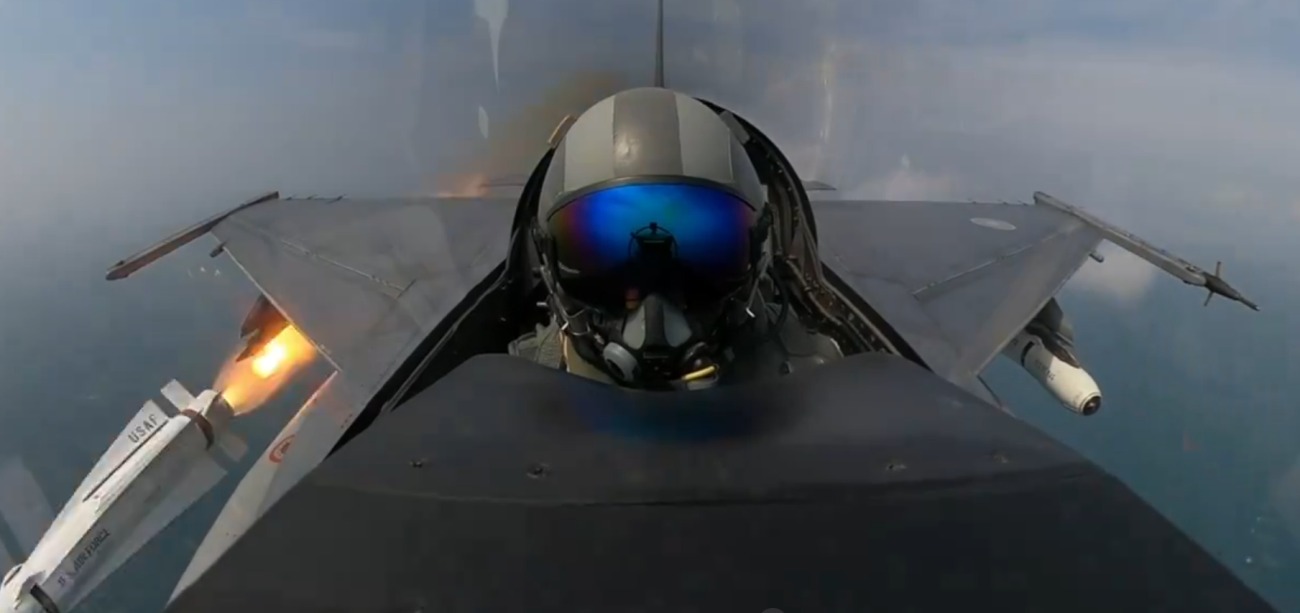A video of the live-fire training exercises featuring fighter jets, missiles, and laser-guided bombs was released by Taiwan’s military press agency on May 10, ten days before the much-awaited Presidential inauguration.
China’s H-20 Stealth Bomber Threatens ‘Easy Penetration’ Of Himalayan Border; How Can IAF Respond?
Military News Agency reported that the air force conducted routine training exercises for its jet pilots “to enhance precision strike capabilities in aerial combat.”
The agency stated that the fighter jets were outfitted with laser-guided bombs and American-made Maverick missiles to target “sea and land targets at the offshore reef range near Penghu,” a small group of islands under Taiwanese administration.
In the footage published on the agency’s website, Taiwanese military personnel could be seen fitting projectiles under the wings of the jets. These projectiles had “US Air Force” written on them.
The footage featured a two-seat F-16V taking off from the Chiyai air base, equipped with two Maverick missiles, one on each wing’s central pylon.
A few seconds into the video, an AGM-65 Maverick missile is fired. The missile fired in the drill is a close-range precision strike weapon manufactured by Raytheon (now RTX) that is used against tactical targets like fortified bunkers, hangars, artillery positions, ground aircraft, and troop concentrations.
Liberty Times said that the Taiwanese Air Force rarely reveals the firing of these missiles. The video seemed to be an overt display of force by Taiwan in the face of the mounting military threat from China.
Beijing considers Taiwan to be a part of its territory and has not ruled out occupying the island with force.
罕見畫面☝️!F-16V 戰機裝掛「AGM-65B小牛飛彈」對陸上目標實施炸射!#ROCArmedForce #ROCAF #F16V #ProtectOurCountry #ROC #Taiwan🇹🇼 pic.twitter.com/jblZarCY4r
— 軍聞社 Military News Agency, ROC(Taiwan)🇹🇼 (@mna_roc) May 9, 2024
While China has relentlessly been cornering Taiwan by dispatching its combat aircraft and ships near the self-ruled island state, the campaign of intimidation has become more intense with the new pro-democracy President set to assume office.

China Upped The Ante Against Taiwan
Before the January Presidential election, China claimed that Lai’s election would bring “war and decline” to Taiwan. Ever since the candidate of the Democratic Progressive Party (DPP) was elected by the majority, Beijing has upped military activity in the strait.
According to some commentators, Beijing is going the extra mile to undermine the long-standing status quo across the Taiwan Strait. This comes when Taiwan is preparing to hand over power to the new President. This appears to be an attempt to see how the new Taiwanese administration would react to Beijing’s intensified pressure.
If that observation is correct, Taiwan may have sent a loud and clear message to China with its military drills. Earlier this week, Taiwan’s deputy minister of defense said emphatically that the island’s armed forces were ready for any hostile action China could take when President-elect Lai Ching-te takes office.
“Before and after May 20, our nation’s military will uphold all combat readiness requirements and pay close attention to the damaging of regional peace and stability by the other side,” Deputy Defence Minister Po Horng-he told reporters.
China is surging ships in the South China Sea, spying and shadowing in Philippine territory, sending aircraft and stationing warships around Taiwan.
Beijing could ramp up military activity before or after Taiwan’s presidential inauguration on 20 May. pic.twitter.com/wQIlliu8Fh
— The_anonymous_wave (@anonymouswave1) May 3, 2024
Taiwan’s administration, which disputes Beijing’s claims to sovereignty, has pointed out often that China has been engaging in “grey-zone warfare,” a strategy of employing erratic tactics — such as sending civilian ships into or near Taiwanese waters — to wear out an adversary without actually engaging in open confrontation.
The strategy of intimidation has become more intense in recent months. Beijing has increased patrols near the nation’s outermost Kinmen islands, a distant territory 200 kilometers from Taiwan across the Taiwan Strait and close to the Chinese province of Fujian.
For instance, Taiwan’s Ministry of National Defense reported on Platform X that at least 15 PLA aircraft and 6 PLAN vessels operating around Taiwan were detected until 6 a.m. (UTC+8) on May 10.
In another episode of hostility, Taiwanese officials said that a record number of Chinese vessels – 11 — entered Taiwan’s waters at the same time on May 9, breaching what is classified as “prohibited” and “restricted waters” surrounding the Kinmen Islands.
Fleet of at least 12 Chinese ships (the most ever) operating within Taiwan’s restricted waters came as close as 4 nautical miles to its territory.
This is the most number of ships within Kinmen’s waters on record.
Source: Ian Ellis pic.twitter.com/w3za2XtZk6
— Clash Report (@clashreport) May 10, 2024
As per the Taiwanese coast guard’s statement, three Chinese fishing boats and seven Chinese warships, comprising maritime patrol and fishing ships, participated in a maritime drill within the restricted waters of Kinmen on the afternoon of May 9. These ships came as close as four nautical miles (7.4 kilometers) from Liaoluo Bay on Kinmen Island. Simultaneously, four Chinese coast guard vessels ventured into prohibited waters south of Kinmen.
As the Taiwanese government announced the Chinese incursion in Taiwan’s waters, military observers almost unanimously said it was a Chinese ‘warning’ ahead of Lai taking oath as President. One observer pointed out that China enhanced its military presence around Taiwan before and after every significant political event in the island state.
- Contact the author at sakshi.tiwari9555 (at) gmail.com
- Follow EurAsian Times on Google News





